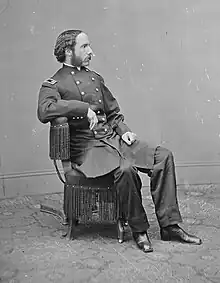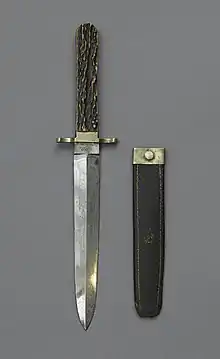Henry Rathbone | |
|---|---|
 1865 Mathew Brady photograph of Rathbone | |
| Birth name | Henry Reed Rathbone |
| Born | July 1, 1837 Albany, New York, U.S. |
| Died | August 14, 1911 (aged 74) Hildesheim, Prussia, Germany |
| Buried | Stadtfriedhof Engesohde (disinterred in 1952) |
| Allegiance | |
| Service/ | |
| Years of service | 1861–1870 |
| Rank | |
| Unit | 12th U.S. Infantry |
| Battles/wars | American Civil War |
| Spouse(s) | |
| Children | Henry Riggs Rathbone Gerald Lawrence Rathbone Clara Pauline Rathbone |
| Relations | Ira Harris (stepfather and father-in-law) |
| Other work | Attorney |
Henry Reed Rathbone (July 1, 1837 – August 14, 1911) was a United States military officer and lawyer who was present at the assassination of President Abraham Lincoln. Rathbone was sitting by Lincoln when the president was fatally shot by John Wilkes Booth at Ford's Theatre; when Rathbone attempted to prevent Booth from fleeing, Booth stabbed and seriously wounded him. Rathbone's mental state deteriorated after the assassination, and in 1883, he fatally shot his wife, Clara Harris, in a fit of madness, later being declared insane by doctors and living the rest of his life in a lunatic asylum.
Early life and family
Henry Rathbone was born in Albany, New York, one of four children of Jared L. Rathbone, a merchant and wealthy businessman who later became the first elected Mayor of Albany, and Pauline Rathbone (née Penney).[1] Upon his father's death in 1845, Rathbone inherited $200,000 (the equivalent of $6,300,000 in 2022). His widowed mother married Ira Harris in 1848. Harris would later be appointed U.S. Senator from New York after William H. Seward became Abraham Lincoln's Secretary of State in 1861.
As a result of the marriage, Ira Harris became Rathbone's stepfather. Harris was a widower with four children of his own,[2][3] including a daughter named Clara, who became Rathbone's stepsister when the two were approximately ages 11 and 14.[4][5] Despite being step-siblings, they formed a close friendship and later fell in love, becoming engaged shortly before the American Civil War.[6] The couple married on July 11, 1867, and had three children: Henry Riggs (born February 12, 1870), who later became a U.S. Congressman; Gerald Lawrence (born August 26, 1871); and Clara Pauline (born September 15, 1872).[7]
Legal and military career
Rathbone studied law at Union College, where he was known to miss many classes, and worked in a law partnership in Albany. In 1858, he entered the New York National Guard, where he worked as a judge advocate. Shortly after this, he was selected to be sent to Europe as an observer during the Second Italian War for Independence. He entered the Union Army at the start of the American Civil War[8] and served as a captain in the 12th Infantry Regiment at the Battle of Antietam and the Battle of Fredericksburg.[9] In 1863, he was pulled from frontline duty and given a desk job. By the war's end, he had attained the rank of major. When he resigned from the military in 1870, Rathbone had risen to the rank of brevet colonel.[10]
Lincoln assassination
On April 14, 1865, Rathbone and Harris accepted an invitation from President Lincoln and First Lady Mary Todd Lincoln, to see a play at Ford's Theatre. Rathbone and Harris had been friends with the president and his wife for some time and were invited after Ulysses S. Grant and his wife, Julia, and several others had declined the invitation.[11]

During the play, at about 10:14 pm, noted stage actor John Wilkes Booth entered the presidential box and fatally shot Lincoln in the head with a pistol. As Rathbone attempted to apprehend Booth, Booth slashed Rathbone's left arm with a dagger from the elbow to his shoulder. Rathbone later recalled that he was horrified at the anger on Booth's face.[12][13][14] Rathbone again grabbed at Booth as Booth prepared to jump from the sill of the box. He grabbed onto Booth's coat, causing Booth to fall awkwardly to the stage, perhaps breaking his leg, though some conspiracy theorists said that the injury did not occur until later. Booth nonetheless escaped and remained at large for twelve days.[15][16]
Despite his serious wound, Rathbone escorted Mary Lincoln to the Petersen House across the street, where the president had been taken.[17]
Shortly thereafter, he passed out due to blood loss.[18] Harris arrived soon after and held Rathbone's head in her lap while he lay semiconscious. When surgeon Charles Leale, who had been attending Lincoln, finally examined Rathbone, it was realized that his wound was more serious than initially thought. Booth had cut him nearly to the bone and severed an artery. Rathbone was taken home while Harris remained with Mary Lincoln as the president lay dying over the next eight hours.[19]
Decline in mental health
Although Rathbone's physical wounds healed, his mental state deteriorated in the years following Lincoln's death as he anguished over his perceived inability to thwart the assassination.[20]
After his resignation from the military in 1870, Rathbone struggled to find and keep a job due to his mental instability. He became convinced that Harris was unfaithful and resented the attention she paid their children. He reportedly threatened her on several occasions after suspecting that she was going to divorce him and take the children.[14] During this time, he made multiple unsuccessful attempts to obtain a position as a United States consul.[21]
Rathbone and his family relocated to Germany, where his mental health continued to decline.[22] On December 23, 1883, he attacked his children in a fit of madness. He fatally shot and stabbed his wife, who was attempting to protect the children. He stabbed himself five times in the chest in an attempted suicide.[23] He was charged with murder, but was declared insane by doctors after he blamed the murder on an intruder. He was convicted and committed to an asylum for the criminally insane in Hildesheim, Germany. The couple's children were sent to live with their uncle, William Harris, in the United States.[14]
Rathbone spent the rest of his life in the asylum. He died on August 14, 1911, and was buried next to his wife at the Stadtfriedhof Engesohde cemetery in Hanover, Germany.[14][24]
Depictions
On film and television Rathbone has been portrayed by:
- Earl Schenck in The Dramatic Life of Abraham Lincoln (1924)
- Lloyd Whitlock in The Prisoner of Shark Island (1936)
- Steve Darrell in Prince of Players (1955)
- John Cooler in The Lincoln Conspiracy (1977)
- Sean Baldwin in The Day Lincoln Was Shot (1998)
- Andy Martin in The Conspirator (2010)
- Joseph Carlson in Killing Lincoln (2013)
His experience at the Lincoln Assassination and the murder of Clara Harris, are covered in the non-fiction book Worst Seat in the House: Henry Rathbone's Front Row View of the Lincoln Assassination by Caleb Stephens.[21] Rathbone and Harris are also the subjects of Henry and Clara (1994, published by Ticknor & Fields), a historical fiction novel by Thomas Mallon.[25]
References
- ↑ Essex Institute Historical Collections. Essex Institute Press. 1891. p. 165.
- ↑ Seward, Frances Adeline (1963). Johnson, Patricia Carley (ed.). Sensitivity and Civil War, the Selected Diaries and Papers, 1858–1866, of Frances Adeline (Fanny) Seward. Vol. 2. University of Rochester. p. 719.
- ↑ Ham, Mrs. Thomas H. (1904). A Genealogy Of the Descendants Of Nicholas Harris, M.D. C.I.F. Ham. p. 18.
- ↑ "New-York Historical Society".
- ↑ "On Exhibit: Artifacts, artwork tell stories of these women". March 12, 2020.
- ↑ Pappas, Theodore (August 21, 1994). "Henry And Clara's Cruel Fate". chicagotribune.com. p. 1. Retrieved May 1, 2013.
- ↑ Talcott, Sebastian V. (2001). Genealogical Notes of New York and New England Families. Heritage Books. p. 637. ISBN 0-788-41956-0.
- ↑ Wright, John D. (2012). The Routledge Encyclopedia of Civil War Era Biographies. Routledge. p. 491. ISBN 978-1-136-33150-3.
- ↑ Ruane, Michael E. (April 5, 2009). "A Tragedy's Second Act". The Washington Post. Retrieved October 19, 2011.
- ↑ Jampoler, Andrew C. A. (2008). The Last Lincoln Conspirator: John Surratt's Flight from the Gallows. Naval Institute Press. p. 182. ISBN 978-1-591-14407-6.
- ↑ Steers, Edward (2005). Blood on the Moon: The Assassination of Abraham Lincoln. University Press of Kentucky. pp. 104–105. ISBN 0-813-19151-3.
- ↑ "What Booth Said After He Killed Lincoln". YouTube. Archived from the original on December 21, 2021.
- ↑ Lachman, Charles (2008). The Last Lincolns: The Rise & Fall of a Great American Family. Sterling Publishing Company. p. 288. ISBN 978-1-402-75890-4.
- 1 2 3 4 Hatch, Frederick (2011). Protecting President Lincoln: The Security Effort, the Thwarted Plots, and the Disaster at Ford's Theatre. McFarland. p. 161. ISBN 978-0-786-46362-6.
- ↑ Jones, Mark; Johnstone, Peter (2011). History of Criminal Justice. Elsevier. pp. 274–275. ISBN 978-1-437-73497-3.
- ↑ Kauffman, Michael W. (2007). American Brutus: John Wilkes Booth and the Lincoln Conspiracies. Random House LLC. p. 231. ISBN 978-0-307-43061-8.
- ↑ Reck, Waldo Emerson (1987). A. Lincoln, His Last 24 Hours. McFarland. p. 126. ISBN 0-899-50216-4.
- ↑ Bain, Robert T. (2005). Lincoln's Last Battleground: A Tragic Night Recalled. AuthorHouse. p. 19. ISBN 1-467-02991-2.
- ↑ Kauffman (2007) p.37
- ↑ "The Conspirator: The Plot to Kill Lincoln", National Geographic Channel. Retrieved March 18, 2012
- 1 2 "Worst Seat in the House". Archived from the original on August 19, 2014. Retrieved August 15, 2014.
- ↑ Steers, Edward (2010). The Lincoln Assassination Encyclopedia. HarperCollins. p. 158. ISBN 978-0-061-98705-2.
- ↑ Swanson, James L. (2009). Manhunt: The 12-Day Chase to Catch Lincoln's Killer. HarperCollins. p. 372. ISBN 978-0-061-80397-0.
- ↑ Smith, Gene (February–March 1994). "The Haunted Major". American Heritage. 45 (1): 2.
- ↑ De Haven, Tom (August 19, 1994). "Thomas Mallon". Entertainment Weekly. Archived from the original on January 3, 2014. Retrieved January 3, 2014.